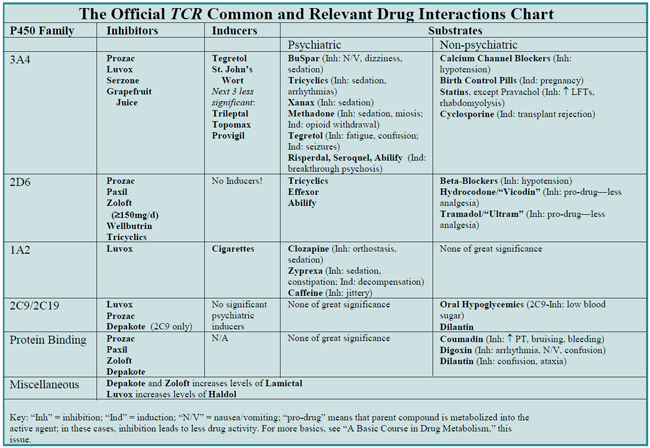Home » Drug-Drug Interactions You Need to Know
Drug-Drug Interactions You Need to Know
July 1, 2003
From The Carlat Psychiatry Report
Daniel Carlat, MD
Dr. Carlat has disclosed that he has no significant relationships with or financial interests in any commercial companies pertaining to this educational activity.
Drug interactions are enormously complicated. In tried and true TCR fashion, I have tried to make this topic easier to stomach. Nonetheless, you can skip this article if you make a decision to avoid prescribing the following medications:
Chances are good, however, that you prefer to have your prescribing options a little more open than this; if so, read on.
Table: The Official TCR Common and Relevant Drug Interactions Chart

The centerpiece of this article is "The Official TCR Common and Relevant Drug Interactions Chart" above.
This bare-bones memory-jogger focusses on drug interactions that meet two criteria:
1) Psychiatrists commonly encounter them;
2) They are likely to cause clinically significant problems.
I suggest that you use the Chart in the following way. Your patient comes in, and you review what meds he or she is on. If your patient is taking one of the drugs classified as an "inhibitor", and you are thinking of prescribing a substrate of that P450 family, start the new drug at about half the usual starting dose, and warn the patient of the potential toxicity side effects listed in the table. Then titrate the dose up to the normal therapeutic dose more slowly than you might otherwise do so, checking any relevant levels along the way. If you are thinking of starting an "inducer," consider increasing the substrate dose by 50-100% about two weeks into the medication trial, as it takes that long for inducers to work.
Don't forget the tricky events known as "reversal of induction" or "reversal of inhibition." An example of reversal of induction is the patient on clozapine who finally succeeds in quitting smoking (tobacco is a potent inducer of clozapine metabolism) only to be rewarded with symptoms of clozapine toxicity, including sedation, orthostatic hypotension, and constipation. An example of reversal of inhibition is the patient on Xanax who stops his Serzone (a 3A4 inhibitor), leading to lower than therapeutic Xanax levels and consequent breakthrough panic.
Remember, even when you prescribe one of the evil combinations listed, not all of your patients will be unlucky enough to develop clinical consequences, and even some of these will be pretty mild. But these events occur frequently enough to warrant vigilance.
I've left some "biggies" off the list. You won't find the potent 2D6 inhibitor cimetidine here because it is rarely used these days. Likewise, both Dilantin and Phenobarbitol are potent P450 inducers, but I've never prescribed either one of them and I doubt you have either. And likewise for many other drugs that purists will rake TCR over coals for omitting. An obvious disclaimer is that you should not rely on this table for all your drug interaction information; Dr. Sandson, in this month's Q&A, suggests several useful and comprehensive resources that you should also have at your beck and call.
One other useful tidbit to add to your drug interaction knowledge:
TCR VERDICT:
Drug Interactions: Learn, or get Burned!
General Psychiatry- To avoid causing significant increases in the levels of any other drug, never prescribe the following: Prozac, Paxil, high dose Zoloft, Luvox, Serzone, Depakote, and ask your patient to stop drinking Grapefruit Juice.
- To avoid causing significant decreases in levels of other drugs, never prescribe: Tegretol, St. John's Wort, and ask your patient to stop smoking.
Chances are good, however, that you prefer to have your prescribing options a little more open than this; if so, read on.
Table: The Official TCR Common and Relevant Drug Interactions Chart

The centerpiece of this article is "The Official TCR Common and Relevant Drug Interactions Chart" above.
This bare-bones memory-jogger focusses on drug interactions that meet two criteria:
1) Psychiatrists commonly encounter them;
2) They are likely to cause clinically significant problems.
I suggest that you use the Chart in the following way. Your patient comes in, and you review what meds he or she is on. If your patient is taking one of the drugs classified as an "inhibitor", and you are thinking of prescribing a substrate of that P450 family, start the new drug at about half the usual starting dose, and warn the patient of the potential toxicity side effects listed in the table. Then titrate the dose up to the normal therapeutic dose more slowly than you might otherwise do so, checking any relevant levels along the way. If you are thinking of starting an "inducer," consider increasing the substrate dose by 50-100% about two weeks into the medication trial, as it takes that long for inducers to work.
Don't forget the tricky events known as "reversal of induction" or "reversal of inhibition." An example of reversal of induction is the patient on clozapine who finally succeeds in quitting smoking (tobacco is a potent inducer of clozapine metabolism) only to be rewarded with symptoms of clozapine toxicity, including sedation, orthostatic hypotension, and constipation. An example of reversal of inhibition is the patient on Xanax who stops his Serzone (a 3A4 inhibitor), leading to lower than therapeutic Xanax levels and consequent breakthrough panic.
Remember, even when you prescribe one of the evil combinations listed, not all of your patients will be unlucky enough to develop clinical consequences, and even some of these will be pretty mild. But these events occur frequently enough to warrant vigilance.
I've left some "biggies" off the list. You won't find the potent 2D6 inhibitor cimetidine here because it is rarely used these days. Likewise, both Dilantin and Phenobarbitol are potent P450 inducers, but I've never prescribed either one of them and I doubt you have either. And likewise for many other drugs that purists will rake TCR over coals for omitting. An obvious disclaimer is that you should not rely on this table for all your drug interaction information; Dr. Sandson, in this month's Q&A, suggests several useful and comprehensive resources that you should also have at your beck and call.
One other useful tidbit to add to your drug interaction knowledge:
- Mnemonic for those drugs that can reduce the effects of birth control pills:
“3 T’s and a P:” Tegretol, Topomax, Trileptal, Provigil.
TCR VERDICT:
Drug Interactions: Learn, or get Burned!

Issue Date: July 1, 2003
Table Of Contents
Recommended
Newsletters
Please see our Terms and Conditions, Privacy Policy, Subscription Agreement, Use of Cookies, and Hardware/Software Requirements to view our website.
© 2025 Carlat Publishing, LLC and Affiliates, All Rights Reserved.


_-The-Breakthrough-Antipsychotic-That-Could-Change-Everything.webp?t=1729528747)



